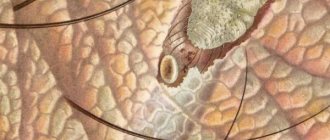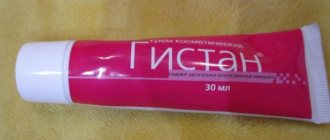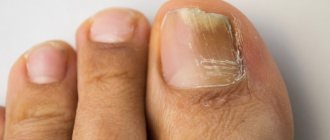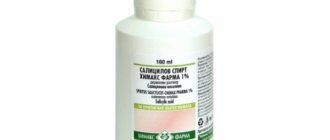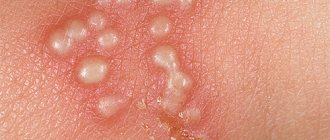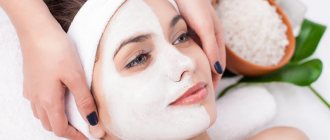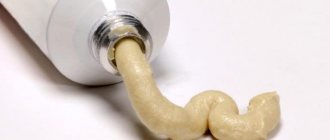Causes and signs of pathology
Psoriasis is not difficult to recognize.
The disease manifests itself first as single, then as multiple rashes on the skin - so-called “psoriatic plaques”. They are convex, raised, inflamed spots of a reddish-pink color, the surface of which is abundantly strewn with silver-gray scales (removed with the slightest mechanical impact). The spread of rashes throughout the body is associated with a host of local and general symptoms:
- Itching, peeling, hyperemia, swelling in the affected areas;
- Decreased performance, apathy, nervousness and depression;
- Dizziness, weakness, and during periods of exacerbation of the disease - increased body temperature.
Stages of progression
Psoriasis on the lower extremities, in the absence of treatment, goes through 3 stages of development:
- initial;
- progressive;
- stationary.
After which the pathological changes stop, the remission stage begins. Without preventive treatment, the disease recurs over time.
The manifestation of the initial stage of the disease on the legs is characterized by the formation of a small single rash, in the form of spots, papules or pustules. Initially, it may occur on the bends of both knees at once. The elements of the rash are red or pink, then their tops are covered with white scales. The initial stage of psoriasis lasts about 3 weeks. During this time, papules or pustules increase in size and form groups.
The initial stage of psoriasis can be stopped if you promptly seek help from a specialist. But most often, people ignore the symptoms of the disease, which is why psoriasis continues to develop. At the progressive stage, the number of psoriatic plaques on the skin of the legs increases; those that are close to each other merge into “paraffin lakes” of various shapes and sizes. Psoriasis on the toes leads to inflammation and peeling of the periungual tissues and damage to the nails.
The progressive period is characterized by the Koebner phenomenon, when a psoriatic rash forms on healed skin, for example, after a cut or scratch.
At the stationary stage, psoriasis of the feet and other areas of the skin of the legs still manifests itself with severe itching and peeling. However, new elements of the rash no longer appear, and the plaques stop increasing in size. There is no inflammatory rim around them, and dry scales appear in its place. If treatment is stopped at this stage, the disease will worsen again. Otherwise, psoriatic plaques stop peeling, some of them disappear completely, some simply become lighter - the remission stage begins.
Basic principles of treating psoriasis using traditional methods
Psoriasis can be cured using traditional medicine. Anyone can prepare homemade ointment for psoriasis. All recipes are simple, understandable and are not accompanied by the same side effects as hormonal drugs.
When choosing a product, consider that:
- with psoriasis, the skin is dry;
- microtrauma of the skin during the acute phase (Koebner phenomenon) initiates the development of plaques;
- secondary infection worsens the course of the disease;
- areas of depigmentation form in place of the plaques;
- Vitamin D deficiency plays an important role in the development of the disease.
Homemade ointment for psoriasis helps to get rid of the main symptoms and increase the period of asymptomatic course of the disease. Homemade ointments and creams can be used for a long period.
Folk remedies should provide the following therapeutic effects:
- thoroughly moisturize the skin;
- absorption of vitamin D by the skin, that is, the medium for ointments should be vegetable or animal oils;
- antiseptic effect;
- anti-inflammatory effect;
- antiexudative effect;
- Relieving itching to prevent scratching.
Ointment for psoriasis is easy to prepare. To do this, it is necessary to understand the cause of the disease and the mechanisms of action of the main components.
Folk remedies for preparing ointments are conventionally divided into groups:
- of plant origin (medicinal herbs);
- animal origin (butter, badger fat);
- synthetic drugs;
- alcohols and ethers;
- petroleum products (solid oil, kerosene).
Everyone chooses their own recipe for ointment for psoriasis, depending on the form of the disease and the severity of the main symptoms.
Symptoms of psoriasis
Most often, this disease occurs in young people aged 20-30 years.
- The most important sign of psoriasis is redness and itching. At first, the rashes are accompanied by slight peeling and itching; at the next stage they are already covered with white scales (plaques). Psoriasis in the groin is a very personal and delicate matter, as it is also accompanied by social problems. Redness appears in the groin area, almost unnoticeable in the initial stage. They are covered with a light white coating and constantly itch. Such scales bleed if they are torn off, and the exposed area shines.
- Papules are in the head area and are not covered with plaques.
- High body temperature, frequent headaches, stress, aching joints.
- Often psoriasis in the groin is accompanied by the manifestation of its symptoms in the armpits and the skin around them.
Ointments with medications
To prepare many folk remedies at home, available medicines are used. For the treatment of psoriasis, aspirin is most often used to create complex ointments.
Aspirin is a non-steroidal anti-inflammatory drug. According to its mechanism of action, acetylsalicylic acid inhibits the synthesis of prostaglandins and other inflammatory mediators, thereby reducing tissue swelling.
Salicylates also have an antimicrobial and fungicidal effect, reducing the possibility of developing secondary infections at the site of the lesion.
To prepare an aspirin-based ointment you will need:
- 50 aspirin tablets;
- celandine;
- elecampane rhizome;
- unrefined sunflower oil;
- petrolatum.
Herbs must be taken in standard pharmacy packaging. Celandine, elecampane and aspirin are ground to a powder. The resulting mixture is poured into a clean container and poured with a liter of vegetable oil. Make sure the oil covers all the dry ingredients.
Place the medicinal-herbal mixture in a place protected from light for a month to infuse. Aspirin is a good preservative that prevents the medicinal product from deteriorating.
During the month of infusion, the product is taken out and heated in a water bath or in a microwave oven to 50–60 degrees C. After infusion, the mixture is filtered and mixed with Vaseline in a ratio of 1:3 (mixture: Vaseline).
Apply the product directly to the affected area of skin, limiting it to its edges. Aspirin-based ointment perfectly relieves inflammation and promotes rapid healing of psoriatic plaques.
Petrolatum
The component is used to soften the effect of Salicylic ointment. The medication prevents the skin from drying out. In combination, it is used for the treatment of palmoplantar psoriasis, as well as plaques located on the extremities. To obtain the medicine, add 2 or 4 parts of Vaseline to the ointment.
Birch tar for psoriasis
This product is used both in pure composition and in combination with other components, including salicylic ointment and castor oil. It is applied to the scalp for psoriasis.
It is recommended to treat the skin in the evening, as tar has a strong odor. It is not recommended to abuse it, as the active component has an effect on the kidneys.
Before use, it is worth considering that tar is difficult to wash off. You should wash your hair with shampoo 2-3 times in the morning, this will eliminate the specific odor.
Hormonal agents
Salicylic ointment for psoriasis is prescribed in conjunction with corticosteroid drugs. The integrated use of these medications allows you to get more pronounced results quickly than when they are prescribed separately. Hormonal drugs are used in extreme cases and not for a long time, since they can provoke a new round of pathology.
- “Diprosalik”, “Belosalik”;
- "Akriderm" and its synonyms (SK, Genta) - consist of betamethasone dipropionate, gentamicin.
From egg yolks
Chicken egg yolks are rightfully recognized as one of the safest and most affordable means for treating psoriasis at home. Ointments based on them perfectly fight scales, renew and heal the skin.
Ointment made from yolks, honey and burdock oil
This remedy is indispensable in the treatment of psoriasis affecting the scalp. To prepare it you will need:
- 1 chicken egg yolk;
- 1 tbsp. honey;
- 1 tbsp. burdock oil.
Carefully move all components and apply to the scalp with light massage movements. For greater effectiveness, you need to cover your head with cellophane and wrap it in a soft terry towel.
You need to stay in this position for approximately 30-40 minutes. During this time, the crusts will soften well, making them easy to remove. After 1-2 weeks of such procedures, the scalp will become perfectly cleansed and healthy.
Yolk ointment or egg oil
Hard boil 20 chicken eggs. Separate the yolks and mash until pureed. Fry in a frying pan without fat for 40-50 minutes, stirring constantly. Then strain the resulting oily mass into a ceramic or glass container.
From yolks, camphor oil and alcohol
- 3 fresh egg yolks;
- 1 tsp camphor oil;
- 150 ml alcohol;
- 150 ml tar.
Mix and place in a dark glass container. Apply to skin using a cotton swab for three weeks.
Ointments based on grease
Propolis or bee glue is used by bees to seal cracks in honeycombs and disinfect them before laying eggs.
Propolis has healing properties. Its peculiarity is the preservation of all trace elements and vitamins after prolonged boiling, so it is widely used in the production of ointments and creams.
Propolis contains all the microelements necessary for humans, as well as vitamins A, B, C, E. Propolis also contains aromatic alcohols, fatty acids, esters, ketones, etc.
The main pharmacological action of propolis:
In the treatment of psoriasis, propolis provides an antimicrobial effect in the area of the psoriatic plaque, which reduces the likelihood of infection of the wound surface, relieves swelling and inflammation of surrounding tissues.
One of the disadvantages of this natural bee pharmacy is its high degree of allergenicity. Propolis contains esters of caffeic acid, which can cause contact dermatitis.
Beeswax is a component of the honeycomb of the hive and is produced by the glands of bees. Its pronounced bactericidal effect is noted. This bee product is often used to heal wounds and burns.
Propolis in combination with butter
To prepare the ointment you will need:
- butter – 200 g;
- propolis – 20 g.
Grind the propolis to speed up the melting process. Chop the butter and combine with propolis. Place both components in a saucepan and put on fire.
Cook with constant stirring to achieve a uniform consistency of the ointment. After boiling, cook for ten minutes and then pour into a clean container. Store the ointment at a temperature not exceeding 15 degrees C.
Before first use, try the product on a small area of skin. If the resulting mixture is well tolerated, lubricate the affected areas of the skin until the symptoms disappear completely.
Ointment with propolis, herbs and sunflower oil
To prepare you will need:
- St. John's wort herb;
- calendula flowers;
- celandine grass;
- propolis – 20 g;
- vegetable oil – 50 g.
St. John's wort, calendula, celandine, take 2 tablespoons each and mix. Add 20 grams of propolis to the medicinal herbs. Grind the ingredients intensively or mash them in a mortar.
Pour the mixture of herbs and propolis with sunflower oil and mix again. You need to add enough oil to get a pasty consistency. The ointment should be applied to psoriatic plaques.
During treatment, it is necessary to monitor the general condition of the patient and local manifestations of the disease. If the clinical picture of psoriasis worsens, you should consult a doctor.
Ointment based on honey and beeswax
To prepare the “honey” ointment you need to take:
- 1 glass of honey;
- 2 tablespoons of birch tar;
- beeswax - 0.5 tablespoon;
- 1 tablespoon of sulfur;
- copper sulfate – 1 tablespoon;
- vinegar essence - 1 tablespoon;
- vegetable oil – 5 tablespoons.
For the preparation of medicines, it is necessary to use only the yolks of eggs obtained from domestic chicken.
Industrially produced eggs may contain antibiotics and other harmful substances, which can aggravate the pathology.
The yolk of a chicken egg contains a rich set of nutrients, including all the microelements and vitamins necessary for the body. The yolk is especially rich in vitamin D.
Vitamin D plays a role in the development of psoriasis. It has been established that a lack of vitamin D3 provokes an exacerbation of the disease. Many medications for the treatment of psoriatic rashes contain synthesized vitamin D3.
In chicken yolks, vitamin D3 is in the form most absorbed by the body. When applied to the skin, the vitamin relieves inflammation and enhances tissue regeneration.
To treat psoriasis, the following ointment recipes using yolk are used.
Monocomponent ointment made from egg yolks
To prepare the medicine you will need 20 chicken yolks.
Boil the eggs hard until done. Cool and peel. Separate the yolks from the whites. Then heat the frying pan and add the mashed yolks. There is no need to add vegetable oil or butter.
The ointment should be prepared with constant stirring. Care must be taken to ensure that the mixture does not burn. The preparation method is long and painstaking. After an hour, you will notice that an oily liquid is released from the boiled yolks.
The resulting oil contains a large amount of vitamin D. When applied externally, the oil well moisturizes and nourishes keratinized epithelial scales. The nutrients contained in the oil help accelerate the regeneration of epithelial cells.
Carefully separate the oil from the pulp using gauze or a bean bag. The above number of eggs will yield about 10 ml of oil.
The oil should be applied to the affected areas of the skin. When treating with chicken yolk oil, it is necessary to limit exposure to bright sun to avoid an overdose of vitamin D.
Egg yolk ointment with ethanol
To prepare the medicine you will need:
- 4 eggs;
- 150 ml ethanol 70%;
- 150 ml birch tar;
- 80 ml camphor oil.
Solid oil is a synthetic product obtained by thickening mineral oils. In folk medicine, natural solid oil is used, obtained using fatty acids of plant origin.
For psoriasis, the medication can only be used as prescribed by a doctor. It is made with different contents of the active component - salicylic acid (concentration varies from 0.5% to 5%). The use of the medication depends on the severity of the symptoms and has the following features:
- Apply ointment to the affected areas once a day, after pre-treating the skin with an antiseptic.
- The drug is applied to large areas every other day.
- In case of increased skin sensitivity, add 2-4 parts of Vaseline or baby cream to one part of the product.
- Salicylic ointment can be used for psoriasis in different concentrations on different areas of the skin.
- To avoid burns and complications, do not use medicine that contains more than 2% salicylic acid.
- Treatment should be discontinued if the patient experiences burning or itching symptoms.
- For complicated forms of psoriasis, the product is applied and left overnight under an occlusive dressing.
The course of therapy lasts for two weeks, the maximum can be 21 days. With longer use of the drug, addiction develops and the effectiveness of treatment decreases. In addition, there is a negative effect on renal function and blood clotting.
Uses of baking soda
Another means of cleansing the body of allergens and toxins is regular baking soda. This is a medicinal product that is taken orally in the form of a pre-prepared solution.
To obtain it, you need to take 0.5 spoons of powder and stir it in a glass of heated water. As a result of these processes, a fizzy drink is obtained, which must be consumed every morning.
Related article:
All about choosing a lotion for psoriasis
Baking soda can also be used as an external treatment. The powder ideally dries out ulcers and accelerates the process of scales falling off.
Soda is used as an ointment and external remedy as follows::
- You need to moisten a cotton pad in a fairly thick soda mixture and apply it to the problem area of the skin;
- You can use hot compresses based on liquid soda solution. A towel is moistened in it and applied to the psoriatic lesions until it cools completely.
Another very effective external treatment for psoriasis is a special soda ointment - you can prepare it from a teaspoon of soda itself, 3 egg yolks, a glass of chicken fat, 100 grams of chaga and a teaspoon of fir oil.
This mixture can be used independently, or you can improve its properties by adding tar and laundry soap to it in the amount of two tablespoons. The resulting mixture should be rubbed into problem areas of the skin overnight.
Medical kerosene can be used as an external remedy for psoriasis; treatment with copper sulfate is also indicated. These are quite strong drugs, each of which can cause an allergic reaction. For this reason, it is very important to obtain prior consultation with a dermatologist before use.
The use of salicylic ointment for scalp psoriasis
Salicylic ointment also helps to clear plaques from the scalp. The use of this drug for psoriasis of the scalp is difficult due to the complexity of application. Hair not only interferes with the procedure, but is also difficult to wash off. During treatment, you must adhere to the following recommendations:
Drug effects on the disease
Psoriasis is a disease that affects the skin for reasons that even an experienced doctor cannot always determine, so it is recommended to treat the symptoms with medication using a combination of medications and additional measures. Medicines must be prescribed by a doctor - self-medication can lead to dangerous complications and rapid development of the disease.
Treatment with drugs occurs according to the following scheme:
- local (external) use of hormonal agents (Psoril, Cytopsor, Berestin);
- a diet that normalizes metabolic processes in the body;
- non-hormonal medications with a moisturizing, stopping cell division, restorative effect (Zinc, Solidol, Salicylic ointment);
- physiotherapeutic manipulations (ultraviolet irradiation of blood, excimer laser, cryotherapy);
- taking vitamin complexes (Aevit, Hepavit).
The disease can cause nervous disorders and neurasthenia; treatment is often supplemented with the help of psychologists. Below is a table with hormonal and non-hormonal drugs.
| Type | A drug | Has an effect |
| Non-hormonal agents | Neftesan | relieves itching and inflammation, relieves pain |
| Losterine | anti-inflammatory, exfoliating effect | |
| Daivonex | prescribed for vulgar psoriasis | |
| Antipsorin | relieves inflammation and irritation | |
| Hormonal agents | Hydrocortisone ointment | anti-allergenic, relieves itching, suppresses skin immunity |
| Ultralan | relieves itching, is anti-allergenic | |
| Lorinden | relieves pain and inflammation, suitable for hairy areas | |
| Flucinar | used in advanced cases |
Application of sulfur-salicylic ointment
Serno, a salicylic ointment, is often prescribed for psoriasis. It effectively relieves the manifestations of skin ailments. In addition to salicylic acid, it contains petroleum jelly and sulfur. For the treatment of psoriasis, a 2-5% form of the medication is used, which can be purchased in a pharmacy in finished form or ordered from pharmacists.
The drug is an analogue of Salicylic ointment, has local irritant and anti-inflammatory properties, has keratoplastic (-lytic), antiparasitic, antibacterial effects. After use, skin may feel dry and have a sulfurous odor.
Contraindications
Instructions for use indicate that Salicylic ointment for psoriasis may not be used by all patients. It is inadmissible to use the medication:
During the treatment of psoriasis and other dermatoses in children and pregnant women, the product should not be applied simultaneously to several affected areas of the body. The salicylic acid included in the composition enhances the absorption of other drugs and can increase the degree of side effects of the drug Methotrexate and hypoglycemic medications.
Effective treatments
Treatment of psoriasis on the elbows should be carried out in a complex that includes the following:
- taking vitamins;
- diet;
- treatment with external means;
- physiotherapy;
- phototherapy.
When treating diseases on the knees, topical medications (ointments, creams) are used. It is possible to prescribe sedatives and antihistamines for complex treatment. If there is excessive bleeding, anti-inflammatory drugs are prescribed.
Treatment of psoriasis on the palms and soles is quite problematic. This is primarily caused by constant irritation of these parts due to friction from clothing and frequent washing. If treatment with external means does not give a positive result, then ultraviolet irradiation is prescribed.
Drug interactions
Petrolatum
The component is used to soften the effect of Salicylic ointment. The medication prevents the skin from drying out. In combination, it is used for the treatment of palmoplantar psoriasis, as well as plaques located on the extremities. To obtain the medicine, add 2 or 4 parts of Vaseline to the ointment.
Birch tar for psoriasis
This product is used both in pure composition and in combination with other components, including salicylic ointment and castor oil. It is applied to the scalp for psoriasis. It is recommended to treat the skin in the evening, as tar has a strong odor. It is not recommended to abuse it, as the active component has an effect on the kidneys. Before use, it is worth considering that tar is difficult to wash off. You should wash your hair with shampoo 2-3 times in the morning, this will eliminate the specific odor.
Hormonal agents
Salicylic ointment for psoriasis is prescribed in conjunction with corticosteroid drugs. The integrated use of these medications allows you to get more pronounced results quickly than when they are prescribed separately. Hormonal drugs are used in extreme cases and not for a long time, since they can provoke a new round of pathology.
The main drugs used for the treatment of psoriasis containing steroids and salicylic acid as active components are:
These drugs are prescribed when the body does not accept pure corticosteroids. They treat small areas of lesions. The treatment regimen includes one-time daily use for no more than 2 weeks. After the therapy period, take a break for 7 days, then treatment can be repeated. The combined use of hormones and salicylic acid gives a quick cleansing effect.
Medicine "Bepanten plus"
For psoriasis, the medication is used in combination with Zinc and Salicylic ointment. The composition of three components, taken in equal proportions, is widely used for the treatment of various skin ailments.
The composition of the drug "Bepanten Plus" includes dexpanthenol, which is converted into pantothenic acid in the epidermal cells. This substance is beneficial for the skin, nourishes it and accelerates scarring.
Another active ingredient is chlorhexidine, which has an antiseptic effect. The cream obtained on the basis of Salicylic ointment and the drug “Bepanten” must be used every day for 7 days.
After this, it is recommended to treat the skin 2-3 times for preventive purposes.
The drug is available in the form of a paste with a thick, uniform consistency. It is prescribed for the treatment of psoriasis and other dermatoses, the symptoms of which occur with inflammation. The active ingredients are zinc oxide and salicylic acid. The medicine effectively relieves inflammation.
Serno, a salicylic ointment, is often prescribed for psoriasis. It effectively relieves the manifestations of skin ailments. In addition to salicylic acid, it contains petroleum jelly and sulfur. For the treatment of psoriasis, a 2-5% form of the medication is used, which can be purchased in a pharmacy in finished form or ordered from pharmacists.
The drug is an analogue of Salicylic ointment, has local irritant and anti-inflammatory properties, has keratoplastic (-lytic), antiparasitic, antibacterial effects. After use, skin may feel dry and have a sulfurous odor.
Cream "Zorka" is a drug from the Russian company Farmaks.
It contains no hormones, toxins or other harmful substances. Initially, the cream was intended to treat skin diseases in animals and treat the udder of cows.
After a detailed study of the product, experts found that Zorka cream effectively copes with dermatological problems in people and treats psoriasis.
Composition and pharmacological properties of the product
How does Zorka cream affect the skin for psoriasis? During the treatment process, it softens and heals irritated skin, relieves the inflammatory process in the dermal structure. Pure natural raw materials make the product hypoallergenic, so hypersensitive patients, children, and pregnant women can use the cream.
To prevent Zorka from losing its beneficial properties, it should be stored in a dry room away from direct sunlight. Recommended temperature range is from 6 to 23°C.
Cream Zorka: instructions for use for psoriasis
For therapeutic and prophylactic purposes, Zorka cream for skin diseases is applied to areas damaged by psoriasis.
The product must be distributed evenly, with light movements, without putting pressure on the problem area. Treatment is carried out 4 times. per day. The last procedure is performed no later than 1 hour before going to bed.
If you have symptoms of psoriasis on the face. whose skin is of the oily type, it is better not to use Zorka cream. The nourishing product worsens the permeability of pores and makes it difficult for the skin to breathe.
Analogues of cream "Zorka"
What can replace Zorka cream for psoriasis, which is treated at home? Recently, the “Power of the Forest” cream, intended for people, has been competing with a useful, proven product. There is no fundamental difference between the drugs. They are almost identical in composition and are used only externally.
“Forest Power” is saturated with flavoring and does not contain kerosene, but it costs three times more than the drug we are considering (about 400 rubles). Zorka cream does not have a very pleasant smell, but its price is affordable: from 40 to 100 rubles for a 200 mg jar. A jar weighing 750 mg costs about 200 rubles.
You can prepare your own cream for psoriasis using birch tar and oil extracts of vitamins E and D as a basis. You can also grind dry raw materials of celandine and calendula into powder and mix with Vaseline. The result is a softening cream with an antiseptic effect.
Reviews from doctors and patients
Pay attention to the main substance and the basis of the hormonal ointment (excipients). Ointments mainly differ in the active substance, usually some kind of hormone. For example, betamethasone, methylprednisolone, clobetasol, mometasone, alklometasone, etc. The most effective, in my opinion, is betamethasone, found in such ointments as Belosalik, Beloderm, Daivobet.
It is also important to pay attention to the base of the ointment. Usually this is petroleum jelly; more expensive ointments use lanolin and wax. Solid oil and Naftalan are also used as bases. Each of us is looking for effective ointments and creams, but the problem is that our bodies are all different and react differently to this or that drug.
You can only find an effective remedy for psoriasis by constantly trying out ointments. In my opinion, effective ointments for psoriasis. Skin-cap and Daivonex and ointments based on grease and herbs, but I know many people to whom these drugs are like a poultice for the dead. Only your body knows the answer to this question.
I have made a selection of the most effective hormonal ointments for psoriasis. But it’s better to start treatment, not with hormonal ointments, hormones harm our health.
Russian ointment for psoriasis
A big plus of Domestic ointments is their low cost compared to imported drugs, especially in times of crisis. When prices for imported medicines increased quite significantly. And the quality of Russian drugs today is quite good; if there is a domestic analogue of the ointment, then it’s worth thinking about buying it.
I use Akriderm ointment on the scalp, mix it with salicylic ointment and smear it on my head. The truth is that the paradox is that it is not always easier to find Russian ointment than imported one. There is an analogue of Akriderm, Rederm, but for some reason it is more difficult to find in a pharmacy, but it costs less than Akriderm.
Akriderm ointment for psoriasis
Which Akriderm should I use for psoriasis? Usually Akriderm SK ointment and simply Akriderm ointment or cream are used, the only difference is the presence of salicylic acid.
The drug inhibits the accumulation of leukocytes and prevents the formation of inflammatory edema. It has anti-inflammatory, antiallergic, antiexudative, vasoconstrictive, antipruritic effects.
How to treat psoriasis at home?
Do not despair if you are diagnosed with psoriasis. To treat this disease, expensive drugs are not always needed. Many of them can be done with your own hands, and the effectiveness of treatment in this case will not suffer in any way. Many recipes have survived to this day with which our ancestors treated psoriasis and achieved some success.
But, before preparing an ointment recipe and starting treatment, it is recommended to consult with a dermatologist, who will rule out the presence of individual intolerance to individual ingredients of the chosen product and make a prognosis regarding the further progress of the disease.
The result of treating psoriasis at home is quite possible, but the only difficulty will be the selection of a truly effective remedy, since traditional medicine recipes are presented in a huge number and which one is most suitable for a particular person is difficult to determine. All that remains is to try.
We will not consider ointment recipes that require certain fish scales, animal fat and other components as active ingredients, which are not always possible to obtain in our time. Let's pay attention to recipes that consist of simple ingredients and can be prepared without difficulty at home.
Effective home recipes
Usually mild and limited forms of psoriasis begin to be treated with local remedies. A homemade medicinal ointment for psoriasis is ideal. This external remedy is designed to simultaneously solve several important medical problems:
- Minimize the inflammatory process on the skin;
- To first assist in drying and then in removing psoriatic plaques from the affected areas;
- Prevent the appearance of new rashes on the face and body;
- Launch natural mechanisms of regeneration of damaged epidermal cells;
- Relieve the classic symptoms of psoriasis on the skin - itching, peeling, hyperemia, swelling, pain;
- Moisturize, nourish, protect dry areas of the epidermis affected by psoriasis.
All folk ointments for psoriasis consist of a fatty base (vegetable oil, grease, cosmetic petroleum jelly) and active ingredients with antibacterial, anti-inflammatory, exfoliating, antipruritic, wound-healing properties - zinc, salicylic acid, medicinal plant extracts, oil vitamins A, E, etc. d.
Let's look at how to treat psoriasis on the body at home in more detail:
- In pharmacies you can buy birch tar and celandine tincture. These effective external medications demonstrate excellent anti-inflammatory, wound-healing, soothing, and antibacterial effects. They are used as follows: psoriatic plaques on the skin are treated with a small amount of birch tar, left for 1.5-2 hours, then washed off with running water and tar soap, and the psoriasis lesions are treated with celandine tincture. The described manipulations are repeated daily for a month.
- Folk ointments for psoriasis based on tar, in general, are very popular among patients with the corresponding diagnosis. There are many recipes for mixtures with this active ingredient. For example, 3 parts of birch tar are combined with 1 part of ash obtained after burning birch twigs. The prepared product is used to treat psoriatic plaques twice a day for 2 weeks. Therapy is supplemented with a decoction of birch buds (drink it on an empty stomach, half an hour before meals, 1 glass per dose).
- Another ointment for psoriasis at home is based on celery. The root of this plant has excellent antibacterial, wound-healing, nutritional, and anti-inflammatory properties. So, to treat the disease, you can use celery gruel - apply it in an even layer to the affected areas, leave for an hour, and wash off with running water. The treatment is supplemented with celery juice - it is taken twice a day, 1 glass at a time. The optimal duration of such a therapeutic course is 1 month.
- How to treat psoriasis on the body at home? They take several homemade chicken eggs, hard-boil them, remove the yolks, which are then placed in a clean frying pan without oil and fried until a characteristic oily liquid begins to release. It is drained, cooled and applied to psoriatic plaques twice a day until the skin manifestations of psoriasis completely disappear.
What other ointment for psoriasis at home will help cope with the symptoms of this unpleasant disease? Let's look at a few useful recipes:
- 200 g of pre-crushed and melted butter are placed in an enamel bowl, and 10 g of finely chopped propolis is added there. The container is placed on low heat, the mixture is boiled, and boiled for another 10 minutes. The finished composition is cooled, filtered, and skin rashes are treated with it daily. It is recommended to continue this therapy for at least 1 month.
- In a clay vessel, mix 20 g of crushed propolis and 1 tbsp. l. fresh flowers of St. John's wort, string, celandine, calendula. Any vegetable oil is added to the healing raw materials and ground until smooth. The finished ointment is stored in a cool, dark place, and the medicine is applied to psoriatic lesions twice a day until the skin is completely cleansed.
- 1 tbsp. l. Celandine powder (it is obtained by grinding the dry roots and flowers of the plant) is mixed with a tube of cosmetic Vaseline (sold in pharmacies) and applied to psoriatic lesions. The composition is left on the skin for 4 days, then washed off and the affected areas of the epidermis are treated with the medicine again. Treatment is recommended until the skin is completely cleared of the hated rashes.
- 50 g of birch tar is mixed with 30 g of liquid honey, 20 g of petroleum jelly, boric acid and 10 g of fish oil. Next, add the white of 1 chicken egg to the composition, mix all ingredients thoroughly until smooth. The resulting medicine should be treated daily with skin lesions of psoriasis until they completely disappear. It is recommended to store the finished ointment in a dark glass container in a cool place.
- Celandine (root, flowers), walnuts and wolfberries, crushed to a powder, are combined in proportions 4:2:1, add 1 tbsp. l. birch tar or ichthyol, mix thoroughly. The finished ointment should be used to treat psoriatic plaques 1-2 times a day.
- 2 tbsp. l. pre-crushed chicory root is poured with a glass of boiling water and placed in a water bath. After 15 minutes, remove the mixture from the heat, cool, and filter. Next, a piece of natural fabric is soaked in this mixture and applied to the skin lesions affected by psoriasis for 1 hour. The manipulations are repeated daily for a month.
- Dry crushed roots of dandelion, valerian, celandine and dandelion are mixed in equal parts. 1 tbsp. l. pour the resulting composition with a glass of fresh boiling water and boil for 5 minutes. Afterwards, the composition is removed from the stove, cooled, and combined with Vaseline so that an ointment of a homogeneous consistency is obtained. This medicine is used to treat psoriatic plaques on the skin twice a day until remission occurs.
- 2 tbsp. l. liquid glycerin is mixed with 1 tbsp. l. honey The resulting mixture is applied to psoriasis lesions 1-2 times a day.
Folk compositions against psoriasis are only an element of a comprehensive fight against the disease; their use is of an auxiliary symptomatic nature and should be combined with other therapeutic measures.
How to deal with pathology
How to treat psoriasis on the body at home? A competent therapeutic approach is comprehensive and symptomatic. Thus, the standard scheme for combating the disease involves:
- The use of systemic drugs of various spectrums of action;
- The use of pharmaceutical ointments, creams, gels, sprays, emulsions, shampoos with antibacterial, keratolytic, anti-inflammatory, soothing, antifungal effects;
- Physiotherapeutic procedures;
- Therapeutic diet;
- Folk ointments for psoriasis, as well as decoctions, infusions, tinctures, personally prepared based on medicinal plants (for example, string, nettle, celandine, chamomile, calendula, etc.).
Psoriasis goes away instantly if you apply regular...
Read more
Psoriasis is cured instantly! need to smear the skin...
Read more
Contraindications
Folk remedies, from the point of view of doctors, are harmless to the body. Although some of their components have contraindications:
- if the body is sensitized to certain substances;
- use them with caution in childhood;
- pregnant and lactating women due to possible effects on the fetus;
- persons with severe immunosuppression;
- patients with severe psoriasis.
If during treatment with traditional medicine the clinical picture worsens, then therapy should be stopped immediately and consult a doctor for medical help.
During the treatment of psoriasis and other dermatoses in children and pregnant women, the product should not be applied simultaneously to several affected areas of the body. The salicylic acid included in the composition enhances the absorption of other drugs and can increase the degree of side effects of the drug Methotrexate and hypoglycemic medications.
How to use Zorka cream for psoriasis. Reviews from doctors and patients
Salicylic ointment for psoriasis, patient reviews confirm this, is a standard medication used in hospitals and in home treatment. The drug quickly clears the skin of plaques, relieves itching, after which quartz treatment and other procedures can be prescribed. Negative reviews are mainly due to the fact that it is difficult to wash your hair after treatment.
Some patients do not observe positive changes in the treatment of psoriasis with Salicylic ointment, others talk about its effectiveness. This is primarily due to people’s misconceptions about the outcome of therapy.
The ointment is not able to completely get rid of psoriasis, it only allows you to relieve the symptoms of the disease, cleanse the skin of psoriatic plaques, eliminate itching, which makes the patient feel better. Reviews also indicate the effectiveness of the remedy for acne and other skin pathologies.
Spa treatment
Sanatorium-resort treatment of psoriasis is strongly recommended during the period of convalescence. The best resorts are Sochi-Matsesta, Naftalan, and the southern coast of Crimea. Thalassotherapy (southern sun, sea, Matsesta baths) is indicated only during the stationary stage and during the period of regression of rashes.
Patients with the summer form of psoriasis should be referred for treatment at resorts in the summer. The use of radon and pearl baths is shown, but with individual restrictions. More detailed information on sanatoriums and resorts here:
